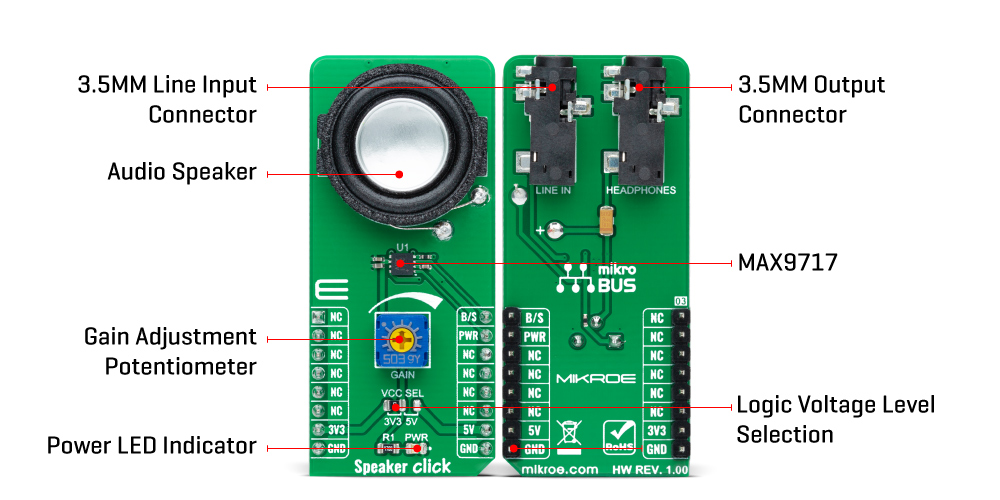OFF
GO LOCAL
| Company | Stock | Price |
|---|---|---|

MIKROE-4662
26 g
Status:
Speaker Click is a compact add-on board that contains an audio power amplifier with a high-quality audio reproduction. This board features the MAX9717, a 1.4W mono bridge-tied load (BTL) architecture audio power amplifier from Maxim Integrated. It delivers 1.4W continuous power into a 4Ω load from a single +5V supply, or 350mW continuous power into an 8Ω load while operating from a single +3.3V supply. Also, the MAX9717 has an adjustable gain amplifier and a headphone sense input that senses headphone connection to the device, muting the speaker while driving the headphone as a single-ended load. This Click board™ is suitable for portable audio applications such as PDAs and portable devices where space and cost are of great importance.
Speaker Click is supported by a mikroSDK compliant library, which includes functions that simplify software development. This Click board™ comes as a fully tested product, ready to be used on a system equipped with the mikroBUS™ socket.
This product is no longer in stock
Availability date:
OFF
| Company | Stock | Price |
|---|---|---|

Speaker Click as its foundation uses the MAX9717, a 1.4W mono bridge-tied load (BTL) architecture audio power amplifier with a high-quality audio reproduction from Maxim Integrated. It delivers 1.4W continuous power into a 4Ω load from a single +5V supply, or 350mW continuous power into an 8Ω load while operating from a single +3.3V supply. This device features Maxim’s industry-leading, comprehensive click-and-pop suppression that reduces audible clicks and pops during Start-Up and Shutdown sequence. Output signal reproduction is possible through the onboard speaker, as well as through the headphone jack located on the bottom side of this Click board™.

Speaker Click communicates with MCU using two GPIO pins routed on the PWM and INT pins of the mikroBUS™ socket labeled B/S and PWR. The MAX9717 features a low-power shutdown mode that reduces quiescent current consumption to 10nA. Entering shutdown mode is possible through the PWR pin, which disables the bias circuitry, and forces the amplifier outputs to GND through an internal 20kΩ resistor. Driving the PWR to a low logic state will cause MAX9717 to enter shutdown mode while the high state will perform a normal operation.
As mentioned before, this Click board™ has an onboard speaker, a 20mm 4Ω Premium Micro Transducer for sound reproduction. This speaker features a neodymium-iron-boron magnet, a light aluminum cone, and a high-temperature polycarbonate frame together with low resonant frequencies and a full-range bandwidth. Also, the MAX9717 features a headphone sense input pin, labeled as B/S, that senses headphone connection to the device through a 3.5mm jack connector labeled as HEADPHONES. This feature is muting the speaker while driving the headphone as a single-ended load. An adjustable potentiometer labeled as GAIN serves to adjust the gain of the MAXS9717‘s internal amplifier.
This Click board™ can operate with both 3.3V and 5V logic voltage levels selected via the VCC SEL jumper. This way, it allows both 3.3V and 5V capable MCUs to use the GPIO lines properly. However, the Click board™ comes equipped with a library containing easy-to-use functions and an example code that can be used, as a reference, for further development.
Type
Speakers
Applications
Can be used for portable audio applications such as PDAs and portable devices where space and cost are of great importance.
On-board modules
MAX9717 - 1.4W mono bridge-tied load (BTL) architecture audio power amplifier with a high-quality audio reproduction from Maxim Integrated
Key Features
1.4W mono audio amplifier, 10nA low-power Shutdown mode, no audible clicks or pops, adjustable gain option, headphone sense feature, and more.
Interface
GPIO
Feature
No ClickID
Compatibility
mikroBUS™
Click board size
L (57.15 x 25.4 mm)
Input Voltage
3.3V or 5V
This table shows how the pinout on Speaker Click corresponds to the pinout on the mikroBUS™ socket (the latter shown in the two middle columns).
| Label | Name | Default | Description |
|---|---|---|---|
| LD1 | PWR | - | Power LED Indicator |
| JP1 | VCC SEL | Left | Logic Level Voltage Selection 3V3/5V: Left position 3V3, Right position 5V |
| VR1 | GAIN | - | Gain Adjustment Potentiometer |
We provide a library for the Speaker Click as well as a demo application (example), developed using MikroElektronika compilers. The demo can run on all the main MikroElektronika development boards.
Package can be downloaded/installed directly from NECTO Studio Package Manager(recommended way), downloaded from our LibStock™ or found on mikroE github account.
Library Description
This library contains API for Speaker Click driver.
Key functions:
speaker_cfg_setup - Config Object Initialization function.speaker_init - Initialization function.speaker_default_cfg - Click Default Configuration function.Examples description
This library contains API for the Speaker click driver. This application controls the operating modes of the Speaker click board™.
The demo application is composed of two sections :
void application_task ( void ) {
log_printf( &logger, "-------------------------rn" );
log_printf( &logger, " Normal Operation Mode rn" );
speaker_normal_operation( &speaker );
Delay_ms( 10000 );
log_printf( &logger, "-------------------------rn" );
log_printf( &logger, " Enter Shutdown Mode rn" );
speaker_shutdown( &speaker );
Delay_ms( 10000 );
}
The full application code, and ready to use projects can be installed directly from NECTO Studio Package Manager(recommended way), downloaded from our LibStock™ or found on mikroE github account.
Other mikroE Libraries used in the example:
Additional notes and informations
Depending on the development board you are using, you may need USB UART click, USB UART 2 click or RS232 click to connect to your PC, for development systems with no UART to USB interface available on the board. The terminal available in all MikroElektronika compilers, or any other terminal application of your choice, can be used to read the message.
This Click board™ is supported with mikroSDK - MikroElektronika Software Development Kit. To ensure proper operation of mikroSDK compliant Click board™ demo applications, mikroSDK should be downloaded from the LibStock and installed for the compiler you are using.
For more information about mikroSDK, visit the official page.
NOTE: Please be advised that any peripheral devices or accessories shown connected to the Click board™ are not included in the package. Check their availability in our shop or in the YMAN section below.